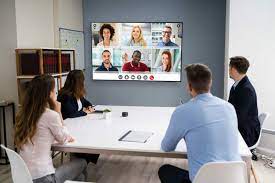Hello!
Thanks to remote work that was fueled by the pandemic shutdowns, today’s work can be done anywhere and everywhere.
Half of the workers surveyed preferred working remotely
 With more workers surveyed by PwC preferring remote work at least three days per week (even after concerns about the pandemic subside), it is certain that the shift to hybrid and remote work models will last a long time.
With more workers surveyed by PwC preferring remote work at least three days per week (even after concerns about the pandemic subside), it is certain that the shift to hybrid and remote work models will last a long time.
Only 20% of executives believe that the workplace will be the same as it was before the pandemic. More than 80% also believe that remote work has made their business more successful. Although I am not the only one who longs to return to the office, the notion of being in the office all week seems to be passé.
Millions of people are looking for new ways to connect with their companies and take part in their processes. Telework is a growing trend. It is, therefore, more important than ever to have audiovisual technology that is flexible, innovative, and future-oriented.
Innovative AV Tech
The best way to create seamless connections between colleagues in the office and remote workers is with AV tech. Many businesses use AV technology in some way. For example, projectors and video equipment are used in conference rooms and common areas. The basics should be familiar to all members of the team.
 But, the possibilities of AV are far greater than most people realize.
But, the possibilities of AV are far greater than most people realize.
What are the emerging trends in AV which are helping to solve communication and collaboration problems and propel hybrid teams forward? Here are four major changes in the AV industry.
1. It is essential to have simple-to-use systems
Future AV tech should not be so complex that only IT-related degree holders can use it.
Instead, AV tools and solutions must be easy to use.
They should be integrated seamlessly into workflows, so that they become part of the process.
 We used to talk with clients about how a typical meeting would start seven minutes late. This was primarily due to technical issues in setting up a screen-share, or video-call.
We used to talk with clients about how a typical meeting would start seven minutes late. This was primarily due to technical issues in setting up a screen-share, or video-call.
Workers have made huge leaps in their knowledge of videoconferencing technology over the last 18 months, despite working largely remotely. The technology is also easier to use and reliable.
This ease of use will be essential for the future workplace. It doesn’t matter if you are in the room or remotely attending a meeting at 2 p.m., it will start on time.
2. Employees and customers have a preference for touchless technology
after more than a decade of worrying about touching items in the community. Touchless devices aren’t new. They’ve been used for many purposes such as hands-free storywalls at children’s hospitals or museums.
Touchless Systems using Bodily Actions
 These same touchless systems could be used to allow workers to use their hands to draw or move images on screens.
These same touchless systems could be used to allow workers to use their hands to draw or move images on screens.
Employees who bring their own devices to work can use touchless AV in a more subtle way. Instead of requiring them to plug their devices into the ports, they can connect using contactless means to microphones or other AV equipment.
Workers can feel more comfortable coming to work if there are fewer touchpoints.
3. A demand for digital signage
Digital signage has many applications in corporate environments. It is difficult to quantify the benefits. Digital signage can be used for a variety of purposes, including as wall art and displaying messages.
Digital signage can be used as a communication device and sends information in real time to any department, facility, warehouse, or other remote location.
Digital signage can also automate tasks so that employees can focus on more important responsibilities.
Some digital signs can guide visitors and workers through complex buildings and large businesses. Some digital signs provide automatically calculated team statistics such as quarterly sales growth and customer satisfaction scores. They also have live inventory. This eliminates the need to manually send reminders or updates.
4. There is hope for more real-life virtual experiences
 The pandemic caused a huge boost in the popularity of Microsoft Teams and Zoom. People still complain that online meetings don’t feel as seamless and as natural as they would like.
The pandemic caused a huge boost in the popularity of Microsoft Teams and Zoom. People still complain that online meetings don’t feel as seamless and as natural as they would like.
Designers and AV Tech Developers Are Looking for Innovative Ways to Innovate
Designers, AV tech professionals, and creators are listening to these concerns and looking for ways to bring new innovations to virtual gatherings.
Spatial audio is the ability to make sounds appear as if they are coming from specific directions. Zoom meetings can feel awkward because everyone is talking simultaneously and all of them seem to be speaking from the same speaker. Spatial audio adjusts the volume and position of sounds to create a more natural sound experience.
Apple already has begun to add spatial audio into its offerings. It could make it easier to bring together remote and in-office employees with the tech’s increasing reliability.
Hybrid work is a trend that seems certain to continue, according to all accounts. It is certain that improvements in AV tech like the ones mentioned here will lead to seamless processes and systems.
Also read: AI Agent for Investors: Analyzing 100 NASDAQ Companies in Minutes
Thank you!
Subscribe to our newsletter! Join us on social networks!
See you!






